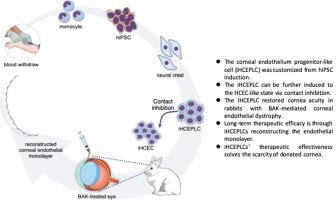当前位置:
X-MOL 学术
›
J. Adv. Res.
›
论文详情
Our official English website, www.x-mol.net, welcomes your feedback! (Note: you will need to create a separate account there.)
The hiPSC-derived corneal endothelial progenitor-like cell recovers the rabbit model of corneal endothelial dystrophy
Journal of Advanced Research ( IF 11.4 ) Pub Date : 2024-05-08 , DOI: 10.1016/j.jare.2024.05.008 Yi-Jen Hsueh , Hung-Chi Chen , Yu-Yun Pan , Fang-Chi Hsiao , Shun-Jie Yang , Mei-Chun Liu , Wei-Yu Lai , Guigang Li , David Hui-Kang Ma , Yaa-Jyuhn James Meir
Journal of Advanced Research ( IF 11.4 ) Pub Date : 2024-05-08 , DOI: 10.1016/j.jare.2024.05.008 Yi-Jen Hsueh , Hung-Chi Chen , Yu-Yun Pan , Fang-Chi Hsiao , Shun-Jie Yang , Mei-Chun Liu , Wei-Yu Lai , Guigang Li , David Hui-Kang Ma , Yaa-Jyuhn James Meir

|
Corneal endothelial dysfunction results in cornea opacity, damaging sightedness, and affecting quality of life. A corneal transplant is the current effective intervention. Due to the scarcity of donated cornea, such an unmet medical need requires a novel therapeutic modality. Customizing patients' corneal endothelial progenitor cells with proliferative activity and lineage restriction properties shall offer sufficient therapeutic cells for corneal endothelial dystrophy. The customized induced human corneal endothelial progenitor-like cell (iHCEPLC) was obtained through cell fate conversions starting from PBMC (peripheral blood mononuclear cell), hiPSC (human induced pluripotent stem cell), and hNCC (human neural crest cell), while it finally reached the iHCEPLC state via a series of induction. Several molecular diagnoses were applied to depict its progenitor state, including RNAseq, FlowCytometer, immunostainings, and rtPCR. Significantly, it can be induced to gain differentiation maturity through contact inhibition. In addition, a BAK-mediated rabbit model of corneal endothelial dystrophy was established in the present study to test the therapeutic effectiveness of the iHCEPLC. After inducing cell fate conversion, the specific HCEC markers were detected by rtPCR and immunostaining in iHCEPLC. Further, RNAseq was applied to distinguish its progenitor-like cell fate from primary human corneal endothelial cells (HECE). FlowCytometry profiled the heterogeneity subpopulation, consistently displaying a subtle difference from primary HCEC. A terminal differentiation can be induced in iHCEPLC, addressing its progenitor-like fate. iHCEPLC can restore the BAK-based rabbit model of corneal endothelial dystrophy. Immunohistochemistry verified that such acuity restoration of the BAK-treated cornea is due to the introduced iHCEPLC, and such therapeutic effectiveness is observed in the long term. Here, we demonstrated that customized iHCEPLC has long-term therapeutic efficacy. As a progenitor cell, our iHCEPLC has a restricted cell lineage nature and can proliferate in vitro, supporting sufficient therapeutic candidate cells. Due to the immune-privileged nature of the cornea, our iHCEPLC proves the principle of therapeutical feasibility in both autogenic and allogeneic modalities.
中文翻译:

hiPSC来源的角膜内皮祖细胞恢复兔角膜内皮营养不良模型
角膜内皮功能障碍导致角膜混浊,损害视力并影响生活质量。角膜移植是目前有效的干预措施。由于捐赠角膜的稀缺性,这种未满足的医疗需求需要一种新颖的治疗方式。定制具有增殖活性和谱系限制特性的患者角膜内皮祖细胞将为角膜内皮营养不良提供足够的治疗细胞。以PBMC(外周血单核细胞)、hiPSC(人诱导多能干细胞)、hNCC(人神经嵴细胞)为起始点,通过细胞命运转换获得定制化的诱导人角膜内皮样祖细胞(iHCEPLC),最终通过一系列感应达到iHCEPLC状态。应用多种分子诊断来描述其祖细胞状态,包括 RNAseq、流式细胞仪、免疫染色和 rtPCR。重要的是,可以通过接触抑制诱导其获得分化成熟。此外,本研究还建立了BAK介导的兔角膜内皮营养不良模型,以测试iHCEPLC的治疗效果。诱导细胞命运转换后,通过 rtPCR 和 iHCEPLC 免疫染色检测特异性 HCEC 标记。此外,应用 RNAseq 来区分其祖细胞样细胞命运与原代人角膜内皮细胞 (HECE)。流式细胞术分析了异质性亚群,始终显示出与原发 HCEC 的细微差别。 iHCEPLC 中可以诱导终末分化,解决其类似祖细胞的命运。 iHCEPLC 可以恢复基于 BAK 的兔角膜内皮营养不良模型。 免疫组织化学证实,BAK治疗后角膜的视力恢复是由于引入了iHCEPLC,并且可以长期观察到这种治疗效果。在这里,我们证明了定制的 iHCEPLC 具有长期的治疗功效。作为祖细胞,我们的 iHCEPLC 具有受限的细胞谱系性质,可以在体外增殖,支持足够的治疗候选细胞。由于角膜的免疫豁免性质,我们的 iHCEPLC 证明了自体和同种异体模式的治疗可行性原则。
更新日期:2024-05-08
中文翻译:

hiPSC来源的角膜内皮祖细胞恢复兔角膜内皮营养不良模型
角膜内皮功能障碍导致角膜混浊,损害视力并影响生活质量。角膜移植是目前有效的干预措施。由于捐赠角膜的稀缺性,这种未满足的医疗需求需要一种新颖的治疗方式。定制具有增殖活性和谱系限制特性的患者角膜内皮祖细胞将为角膜内皮营养不良提供足够的治疗细胞。以PBMC(外周血单核细胞)、hiPSC(人诱导多能干细胞)、hNCC(人神经嵴细胞)为起始点,通过细胞命运转换获得定制化的诱导人角膜内皮样祖细胞(iHCEPLC),最终通过一系列感应达到iHCEPLC状态。应用多种分子诊断来描述其祖细胞状态,包括 RNAseq、流式细胞仪、免疫染色和 rtPCR。重要的是,可以通过接触抑制诱导其获得分化成熟。此外,本研究还建立了BAK介导的兔角膜内皮营养不良模型,以测试iHCEPLC的治疗效果。诱导细胞命运转换后,通过 rtPCR 和 iHCEPLC 免疫染色检测特异性 HCEC 标记。此外,应用 RNAseq 来区分其祖细胞样细胞命运与原代人角膜内皮细胞 (HECE)。流式细胞术分析了异质性亚群,始终显示出与原发 HCEC 的细微差别。 iHCEPLC 中可以诱导终末分化,解决其类似祖细胞的命运。 iHCEPLC 可以恢复基于 BAK 的兔角膜内皮营养不良模型。 免疫组织化学证实,BAK治疗后角膜的视力恢复是由于引入了iHCEPLC,并且可以长期观察到这种治疗效果。在这里,我们证明了定制的 iHCEPLC 具有长期的治疗功效。作为祖细胞,我们的 iHCEPLC 具有受限的细胞谱系性质,可以在体外增殖,支持足够的治疗候选细胞。由于角膜的免疫豁免性质,我们的 iHCEPLC 证明了自体和同种异体模式的治疗可行性原则。











































 京公网安备 11010802027423号
京公网安备 11010802027423号